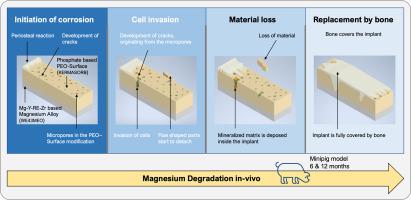Biomaterials Advances ( IF 7.9 ) Pub Date : 2021-08-19 , DOI: 10.1016/j.msec.2021.112380 Carsten Rendenbach 1 , Heilwig Fischer 2 , Alexander Kopp 3 , Katharina Schmidt-Bleek 4 , Henri Kreiker 1 , Sabine Stumpp 4 , Mario Thiele 4 , Georg Duda 4 , Henning Hanken 5 , Benedicta Beck-Broichsitter 1 , Ole Jung 6 , Nadja Kröger 7 , Ralf Smeets 8 , Max Heiland 1

|
Magnesium is a highly promising candidate with respect to its future use as a material for resorbable implants. When magnesium degrades, hydrogen gas is released. High doses of gas emergence are reported to impair osseointegration and may therefore lead to fixation failure. The successful delay and reduction of the degradation rate by applying plasma electrolytic oxidation (PEO) as a post processing surface modification method for magnesium alloy has recently been demonstrated. The aim of this study was thus to compare the degradation behavior of a WE43-based plate system with and without respective PEO surface modification and to further investigate osseointegration, as well as the resulting effects on the surrounding bony tissue of both variants in a miniature pig model.
WE43 magnesium screws and plates without (WE43) and with PEO surface modification (WE43-PEO) were implanted in long bones of Göttingen Miniature Pigs. At six and twelve months after surgery, micro-CT and histomorphometric analysis was performed.
Residual screw volume (SV/TV; WE43: 28.8 ± 21.1%; WE43-PEO: 62.9 ± 31.0%; p = 0.027) and bone implant contact area (BIC; WE43: 18.1 ± 21.7%; WE43-PEO: 51.6 ± 27.7%; p = 0.015) were increased after six months among the PEO-modified implants. Also, surrounding bone density within the cortical bone was not affected by surface modification (BVTV; WE43: 76.7 ± 13.1%; WE43-PEO: 73.1 ± 16.2%; p = 0.732). Intramedullar (BV/TV; WE43: 33.2 ± 16.7%; WE43-PEO 18.4 ± 9.0%; p = 0.047) and subperiosteal (bone area; WE43: 2.6 ± 3.4 mm2; WE43-PEO: 6,9 ± 5.2 mm2; p = 0.049) new bone formation was found for both, surface-modified and non-surface-modified groups. After twelve months, no significant differences of SV/TV and BV/TV were found between the two groups.
PEO surface modification of WE43 plate systems improved osseointegration and significantly reduced the degradation rate within the first six months in vivo. Osteoconductive and osteogenic stimulation by WE43 magnesium implants led to overall increased bone growth, when prior PEO surface modification was conducted.
中文翻译:

6 个月和 12 个月后,PEO 表面改性 WE43 镁板和螺钉的体内骨整合和降解行为得到改善
就其未来用作可吸收植入物的材料而言,镁是非常有前途的候选物。当镁降解时,会释放氢气。据报道,高剂量的气体出现会损害骨整合,因此可能导致固定失败。最近已经证明,通过应用等离子体电解氧化 (PEO) 作为镁合金的后处理表面改性方法,可以成功延迟和降低降解速率。因此,本研究的目的是比较基于 WE43 的板系统在有和没有各自 PEO 表面改性的情况下的降解行为,并进一步研究骨整合,以及对小型猪中两种变体周围骨组织的影响模型。
不带(WE43)和带PEO表面改性(WE43-PEO)的WE43镁螺钉和钢板植入哥廷根小型猪的长骨中。术后 6 个月和 12 个月,进行显微 CT 和组织形态学分析。
剩余螺钉体积(SV/TV;WE43:28.8 ± 21.1%;WE43-PEO:62.9 ± 31.0%;p = 0.027)和骨植入物接触面积(BIC;WE43:18.1 ± 21.7%;WE43-PEO:271.6。 %;p = 0.015) 在 PEO 修饰的植入物中六个月后增加。此外,皮质骨内的周围骨密度不受表面修饰的影响(BVTV;WE43:76.7 ± 13.1%;WE43-PEO:73.1 ± 16.2%;p = 0.732)。髓内(BV / TV; WE43:33.2±16.7%; WE43-PEO 18.4±9.0%; p = 0.047)和骨膜下(骨面积; WE43:2.6±3.4毫米2 ; WE43-PEO:6,9±5.2毫米2 ; p = 0.049) 表面改性组和非表面改性组均发现新骨形成。12个月后,两组间SV/TV和BV/TV无显着差异。
WE43 板系统的 PEO 表面改性改善了骨整合并显着降低了体内前六个月内的降解率。当进行先前的 PEO 表面改性时,WE43 镁植入物的骨传导和成骨刺激导致整体骨生长增加。



























 京公网安备 11010802027423号
京公网安备 11010802027423号